[ 1-18 ]|[ 19-37 ]|[ 38-56 ]|[ 57-64 ]
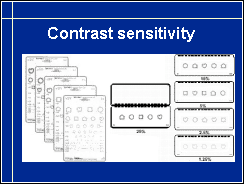
Visual acuity should also be assessed at low contrast levels either using back-illuminated charts or with symbols of one size at different contrast levels.
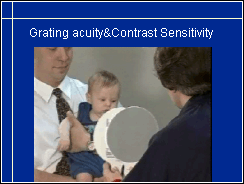
Before the child can respond in a visual acuity test, we can measure grating acuity and roughly assess contrast sensitivity by using low contrast pictures of face. Both measurements are quick when a normally sighted infant is examined. In the assessment of vision of multihandicapped infants and children the measurement often needs to be repeated several times.
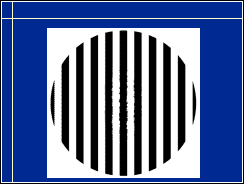
Grating acuity measures visual function at a much larger area of the visual field than visual acuity measured with optotypes. Therefore grating acuity values should never be converted to optotype acuity values. The changes in the image may be only in the centre of the image, as in this case. Broad lines are seen well.
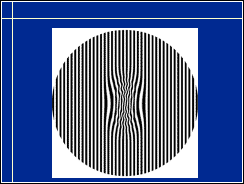
The child responds to narrow lines as well because they can be seen around the most central visual field where the lines are so distorted that small pictures cannot be perceived.
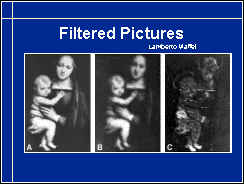
Visual information at the lower spatial frequencies corresponding broad lines is seen at low contrast and is the information that allows us to see round forms. We see in this slide the contribution of different line widths in the visibility of an image: the original picture of Madonna and Child on the left contains both broad and fine lines; from the original picture Dr.Maffei filtered fine lines and we see the result in the picture in the middle. In the picture on the right he filtered the broad lines and left the fine lines that correspond to high grating acuity. We see that the image that does not contain fine lines depicts the original picture better than the picture that has the fine lines. Useful visual information for many tasks is not at the high visual acuity area but at intermediate and broad line widths at low contrast.

In our clinical assessments and often also at schools we only measure visual acuity. For children but also to adult people colour vision is important. Teachers should know if a child's colour perception deviates from normal so that they not think that the child does not understand if the child does not see.
The third basic component of images is movement. Nearly everything moves. Either the target or the observer moves and if those two are stable, the eyes move and therefore visual information is in relative motion. Motion perception is not evaluated during clinical examinations and is therefore an important part of the assessment of functional vision.

After assessment of perception of forms, colours and movement, we need to measure visual field and visual adaptation and describe oculomotor functions. Oculomotor functions include also accommodation, saccades and convergence.

We have clinical tests for form perception and colour vision but perception of motion can be assessed only with ball games. The function of the magnocellular pathway, that carries motion information, can be examined with flicker sensitivity measurements and measurement of detection and discrimination of speed of movement of gratings but so far only in research laboratories. Flicker sensitivity can be measured either with flickering spots of light or with flickering letters.
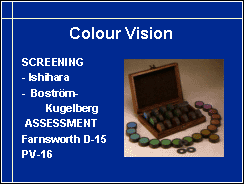
Quantitative measurement of colour vision uses sorting tests. In assessment of low vision, measurements with large colour surfaces depict colour perception in a large area of the visual field and therefore depict functional vision better than the small standard colour vision measurement in the central 1.5 degrees of the visual field. Screening tests function poorly in many cases, they measure only in the red-green axis and miss the irregular colour confusions in other areas of the colour space.

If the school does not have the quantitative colour vision test, the Colour Matching Game on my webpage can be used for informal assessment of colour confusions. If a child seems to confuse some colours, the finding must be confirmed with the proper quantitative tests. The Game gives a good opportunity to teachers and parents to experience the difficulties that a child may have in colour perception and prepares the child for the measurement with the proper test.

Motion perception and visual field can be assessed in different ball games by observing whether the child can follow the movement of approaching ball and whether there are differences between the right and left half of the visual field. Following movements require good motor functions that need to be assessed first.
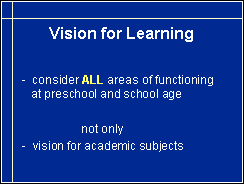
In the assessment of vision for early intervention and special education we need to assess all visual functions, both the quality of the image and the higher cognitive visual functions as well as motor functions. Since most visually impaired children also have other impairments or chronic illnesses, their effect on the use of vision needs to be considered as well. Visual functioning is much more than measurement of visual acuity and visual field.
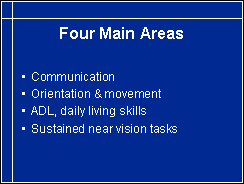
After having measured all the functions that we can measure, we need to assess what the finding mean in terms of the child's every day functioning. The many activities where visual information is important, can be divided into four main groups:
- communication,
- orientation and movement,
- daily living skills and
- sustained near vision tasks like reading and writing.
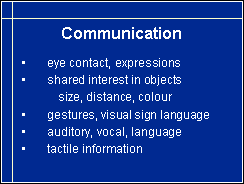
In assessment of vision for communication we need to answer following questions:
- first, what kind of vision does the child have for eye contact and perception of expressions; if fixation is eccentric, all adult people need description of child's fixation behaviour,
- second, is there enough vision for visual sharing of objects of interest with adults, how big objects and at which distance might be seen clearly enough,
- third, can the infant/child see gestures. This is obviously very important in case the infant has hearing impairment but it is important in all communication.
- fourth, role of auditory information in communication, does the infant vocalise, later speak,
- fifth, what is known about the infant's tactile information. Hands are the second pair of eyes for visually impaired infants and children so their function needs to be assessed at the same way as we assess hearing in all visually impaired infants as a part of basic clinical investigations.

In assessment of vision for orientation and movements we have following questions:
- first, how far can the infant/child notice his/her toys, large objects, people and windows,
- second, how far can objects initiate grasping, is the eye-hand-coordination smooth,
- third, what has been learned about use of vision during play situations in little rooms?

"Little room" has in some places become restricted to mean Lilli Nielsen's little room but all small spaces can be used for training spatial concepts, object permanence and exploration. In this slide we see a regular brown box that has been decorated with different tactile surfaces and where there are toys hanging on a thick rubber band so that they can be brought to mouth when grasped.
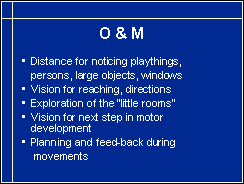
Questions in O&M, orientation and movement are:
- how does visual impairment affect motor learning to reach next step, and
- what can be said about the visual feed-back-loop during hand movements? We have all seen children who look at an object, turn their gaze, often also head, away and grasp the object without looking at it. In these cases it is important to observe what happens when the child does not turn the head but closes his/her eyes. If grasping is easier and more exact when eyes are closed than when they are open, then visual feed-back disturbs motor functions.
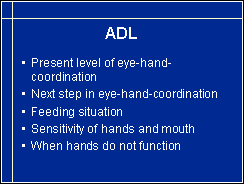
Training of daily living skills is dependent on hand functions and in many tasks on eye-hand coordination. If motor functions are not age appropriate, their training becomes a special part of vision training. On the other hand, eye-hand coordination and vision can be trained during motor exercises.
Effect of visual impairment on the development to reach the next level in daily living skills needs to be assessed. As always, the question is, can we use common learning situations or do we need to use techniques typical to severely visually impaired infants and children.
Feeding situations are often good observation situations. However, if swallowing is difficult or the mouth is hypersensitive, feeding may be the most unpleasant and least motivating activity during the day.
Visually impaired children use their tongue in exploration much longer than sighted children. Actually, many severely visually impaired adult people explore small details with their tongue when fingers and vision do not convey their structure.
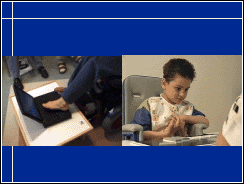
A special group of children are visually impaired children whose hands do not function. When feet are used for writing instead of hands, reading distance becomes unusually long for a visually impaired child. Some of these children are also dysphasic and therefore have a complicated situation in both communication and daily living skills.